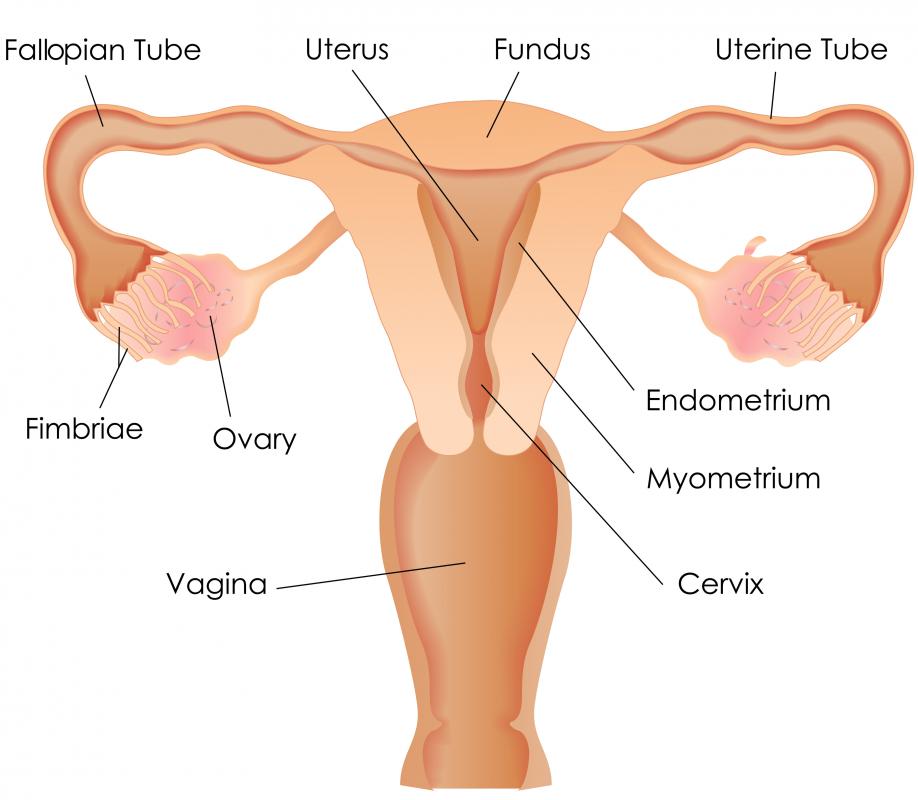At WiseGEEK, we're committed to delivering accurate, trustworthy information. Our expert-authored content is rigorously fact-checked and sourced from credible authorities. Discover how we uphold the highest standards in providing you with reliable knowledge.
What Is Cervical Effacement?
Towards the end of a woman's pregnancy, the fetus begins to drop and the cervix begins to shrink and thin out. This is known as cervical effacement, and it usually starts during the last weeks of a pregnancy. An obstetrician can check for a thinning of the cervix during a physical exam or with an ultrasound machine. As the cervix thins out and the opening dilates, the plug of mucous in the cervical opening will also usually be expelled.
The cervix is the lower portion of the uterus and is joined to the vagina. Normally, the cervix is narrower than the rest of the uterus and it has very thick walls. It is also usually around 1 to 3 inches (3 to 5 centimeters) long and tightly closed at the beginning of a healthy pregnancy.

During the last month of a normal pregnancy, a fetus will usually begin to drop lower in the womb. Around this time, hormones will cause the walls of the cervix to soften. This fetal repositioning also usually triggers the onset of cervical effacement, which might also be referred to as ripening or thinning out.
Cervical effacement and cervical dilation might begin a few weeks before labor begins in some women. In others, however, it may not begin until a few hours before labor. An obstetrician or midwife will usually check a pregnant woman's cervix regularly during the last weeks of her pregnancy. This can be done with an ultrasound machine in some cases, but the cervix can also be checked during a physical examination.
The progress of cervical effacement is usually measured in percentages. If the cervix has not thinned at all, it is considered to be 0% effaced. When the cervical walls are roughly half of their normal size, they are considered to be 50% effaced.

It isn't until the contractions of first stage labor begin that cervical effacement will be complete. At this point, the walls of the cervix will have shortened considerably. Once cervical effacement is at 100%, the walls of the cervix are completely blended in with the rest of the uterus.
Cervical dilation is another sign of impending labor. As cervical effacement progresses, the entrance of the cervix begins to open. Doctors typically check how dilated a woman's cervix is by inserting a finger into the vagina and feeling the cervix. Dilation is usually measured in centimeters, but some doctors may measure it in “fingers,” since the tip of a finger is roughly 1 centimeter (0.4 inches) wide. The plug of mucus inside the cervical opening, known as the bloody show, will usually pass out of the body when dilation occurs.

A woman can not successfully give birth until she is fully dilated, which means that her cervical opening is 10 centimeters (roughly 4 inches) wide. If her cervix is not dilated and thinned out by 40 weeks into the pregnancy, doctors will often consider inducing labor. By assessing how far effaced and dilated a woman's cervix is, as well as the position of the fetus, doctors can evaluate her with something called a Bishop Score. Generally, the lower a woman's Bishop score, the more likely it is that she will have to be induced, or the infant may even need to be delivered via caesarian section.
AS FEATURED ON:
AS FEATURED ON:














Discussion Comments
You are right, Glasis. Too much emphasis is put on due dates. When a baby is good and ready to be born, it will be.
This obsession with due dates seems to have resulted in a spike in the number of induced deliveries. If a woman believes she is a day over the usual 40 weeks, she may be able to convince a doctor to induce labor.
Fortunately, most doctors are loathe to do so unless absolutely medically necessary. Still, induction has become much more common.
Since we also live in an age where a woman can schedule a Cesarean section so a baby is born on the day most convenient for the parents, nothing about modern childbirth should really be surprising.
Although the "due date" for a pregnant woman can be predicted more accurately than ever before, there are myriad factors involved that make complete accuracy impossible.
In most cases, a woman is not aware that she may be pregnant until she misses one or more periods, depending on the regularity of her menstrual cycle. Although rare, some women also still have some spotting even after conception, which could lead to further delay in a pregnancy diagnoses.
Unless a woman had sex only once in a month or more, coming up with the exact date of conception and, as a result, the exact due date, is complicated.
Post your comments